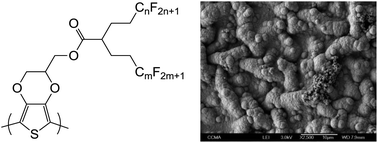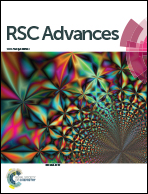Superhydrophobic and oleophobic surfaces containing wrinkles and nanoparticles of PEDOT with two short fluorinated chains
Abstract
Superhydrophobic and oleophobic surfaces are obtained by electrodeposition of original PEDOT derivatives containing two short fluorinated chains. The liquid-repellent properties are due to the combination of high intrinsic hydrophobicity and oleophobicity of polymers due the presence of two fluorinated chains, and the formation of wrinkles and spherical particles induced by the electrodeposition process. The presence of wrinkles and spherical particles and as a consequence the surface hydrophobicity and oleophobicity is correlated to the fluorinated chain length and electrochemical parameters (the deposition charge for the depositions at constant potential and the scan rate and number of scans for the depositions by cyclic voltammetry). Here, the increase in the number of wrinkles and spherical particles induces an increase in the surface roughness increasing especially the surface hydrophobicity while the surface oleophobicity is not always affected. However, it is also possible to increase the surface oleophobicity by a careful choice in the electrochemical parameters. This work also allows the elaboration of super liquid-repellent surfaces with low fluorine content (materials with low bioaccumulative potential).


 Please wait while we load your content...
Please wait while we load your content...